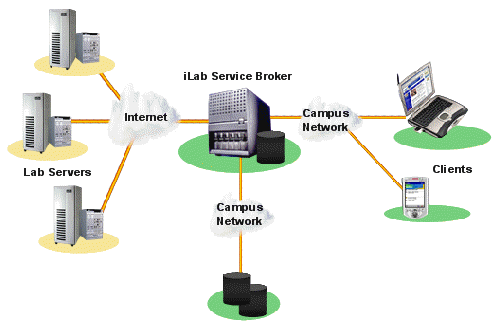iLab Project at MIT: iLab is dedicated to the proposition that online laboratories – real laboratories accessed through the Internet – can enrich science and engineering education by greatly expanding the range of experiments that students are exposed to in the course of their education.
Unlike conventional laboratories, iLabs can be shared across a university or across the world.
The iLabs vision is to share expensive equipment and educational materials associated with lab experiments as broadly as possible within higher education and beyond.
Unlike conventional laboratories, iLabs can be shared across a university or across the world.
The iLabs vision is to share expensive equipment and educational materials associated with lab experiments as broadly as possible within higher education and beyond.
iLab teams have created remote laboratories at Massachusetts Institute of Technology (MIT) in microelectronics, chemical engineering, polymer crystallization, structural engineering, and signal processing as case studies for understanding the complex requirements of operating remote lab experiments and scaling their use to large groups of students at MIT and around the world.
Based on the experiences of the different iLab development teams The iLabs Project is developing a suite of software tools that makes it efficient to bring online and manage complex laboratory experiments. The iLabs Shared Architecture has the following design goals:
- Minimize development and management effort for users and providers of remote labs
- Provide a common set of services and development tools.
- Scale to large numbers of users worldwide
- Allow multiple universities with diverse network infrastructures to share access
iLabs harness the Internet and enable students to use real instruments via remote online laboratories. Conducting experiments motivates students; it also causes them to learn more effectively. Experiments allow a student to compare reality with simulations, collaborate with each other, and follow their curiosity. Yet, significant expense, space and safety considerations prevent many engineering classes from including lab components. By providing online access to remote laboratories, MIT is delivering the educational benefits of hands-on experimentation both to our own students and to students anywhere, at any time.
- The iLabs Project is developing a suite of software tools that makes it easier to bring online and manage complex laboratory experiments. The iLab Shared Architecture (ISA) is a robust, scalable, open-source infrastructure built on web service that has been developed to provide a unifying software framework that can support access to a wide variety of online laboratories. Users and the online laboratories can be globally distributed across an arbitrary number of locations linked only by the Internet. Users access these remote laboratories through single sign-on and a simple standard administrative interface.
